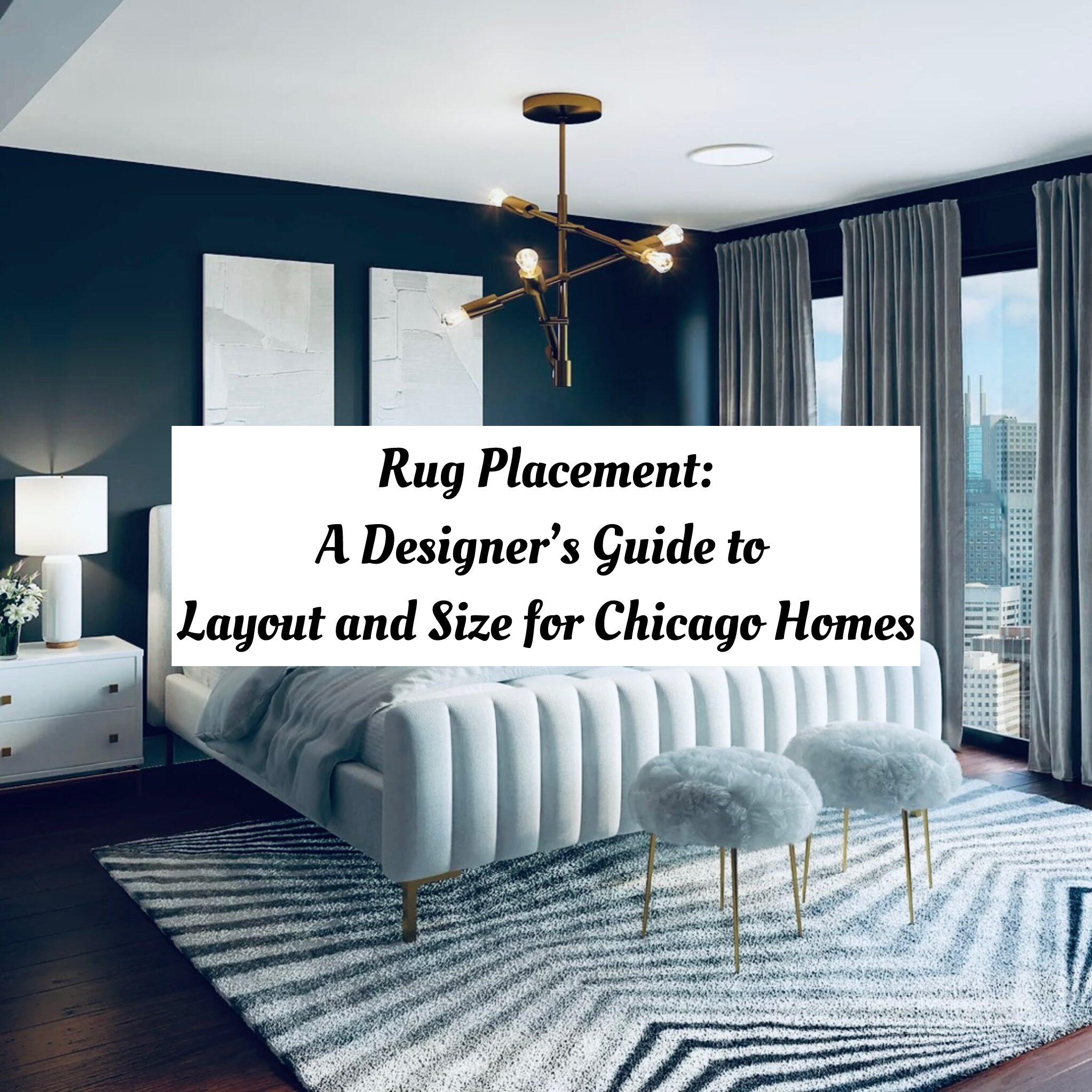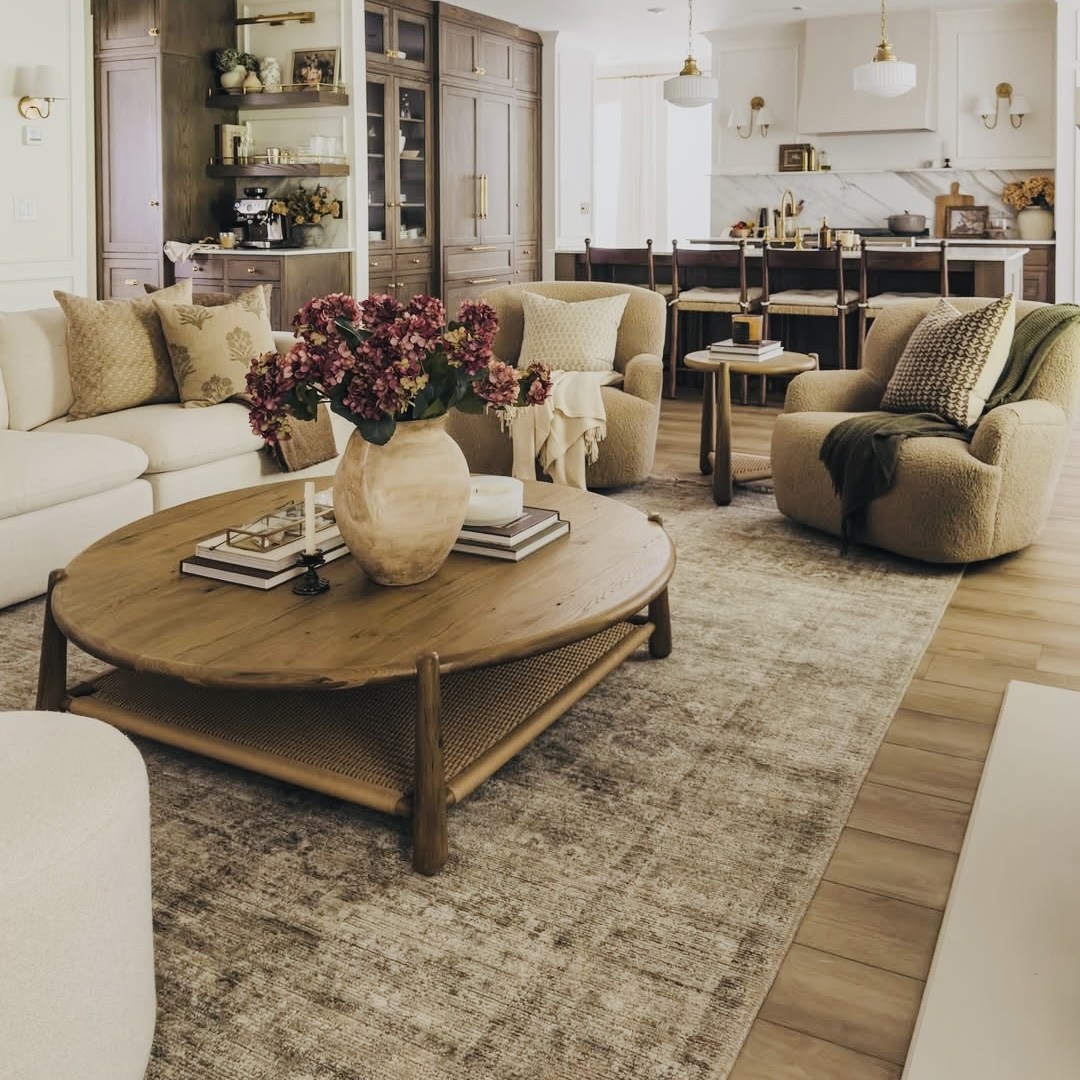Rug Placement – A Designer’s Guide to Layout and Size for Chicago Homes
A beautiful rug can completely transform a room. It adds warmth, color, pattern, and texture, serving as the anchor that ties all your other design elements together. But there’s a common trap that many homeowners fall into: they choose the perfect rug, but the room still feels “off.” Why? Because when it comes to area rugs, layout and size are just as critical as the design itself.
- Talk to our experts now!
The wrong placement or a rug that’s too small can make a space feel disjointed and cheapen the look of your furniture. The right rug placement, on the other hand, creates harmony, balance, and a true sense of intentional, professional design.
“Choosing a rug color to complement your couch is about more than matching — it’s about creating harmony, contrast, and a complete visual story underfoot.”
— Rouzati Rugs
🎨 Quick Guide: Best Rug Colors for Your Couch
| Couch Color | Recommended Rug Colors | Why It Works |
|---|---|---|
| Gray | Soft pastels (blush, sky blue), charcoal, or patterned neutrals | Adds warmth or contrast without clashing; neutrals create a cohesive base. |
| Beige / Tan | Teal, olive green, or rich terracotta | Adds color depth while maintaining a calm and organic feel. |
| Navy / Dark Blue | Mustard yellow, soft gold, or cream | Creates elegant contrast and brightness while preserving richness. |
| Emerald / Green | Rust, cream, or deep brown | Adds warmth and a natural, fresh vibe. |
| Leather (Dark Brown) | Ivory, burnt orange, or vintage Persian patterns | Softens the heaviness of leather and brings elegance. |
This guide will walk you through the designer-approved rules for rug placement and sizing, with a special focus on navigating the unique layouts and challenges of Chicago homes, from historic graystones to modern loft spaces.
The Cardinal Rule: Why Size Matters First
Before we talk placement, we must talk size. The most common decorating mistake is choosing a rug that is too small for the space. A “postage stamp” rug—one that just floats in the middle of a room, disconnected from the furniture—will make your entire room look smaller and fragmented.
As a rule of thumb, bigger is almost always better. A rug should be large enough to unify the main furniture grouping in a room. When in doubt, size up.
Pro Tip: Use painter’s tape to mark a potential rug’s dimensions on your floor. This allows you to visualize the scale and see how it interacts with your furniture before you commit.
Rug Placement Rules for Every Room Type
Once you have the right size, placement becomes the key to creating a balanced, cohesive space. Here are the non-negotiable rules for the most important rooms in your home.
Living Rooms: Creating a Cohesive Conversation Zone
The goal in a living room is to use the rug to define the seating area and visually connect your sofa, chairs, and coffee table into one harmonious “island.”
- The Designer Standard: Front-Legs-On Rule This is the most popular and foolproof method for living rooms. Your rug should be large enough that the front legs of your sofa and any accent chairs rest comfortably on its edge. Your coffee table should sit entirely on the rug. This placement tethers the furniture together, creating a sense of cohesion without requiring an enormous, room-sized rug.
- The Luxury Option: All-Legs-On Rule In larger, open-concept rooms or loft spaces, having a rug large enough for all your furniture—sofa, chairs, and side tables—to sit completely on top of it creates a truly defined and luxurious living area. This approach makes a grand statement and works perfectly to separate a living zone from a dining zone in an open floor plan.
- The Small-Space Exception: The “Floating” Rule If you are in a very small apartment and can’t fit a large rug, you can have a rug that “floats” in the center of the seating area. However, it must be large enough to anchor the coffee table, and the gap between the rug and the furniture should be minimal and balanced on all sides.
Dining Rooms: A Foundation for Feasting
In the dining room, the primary rule of rug placement is functional, not just aesthetic.
- The “24-Inch” Rule Your dining room rug must be large enough to extend at least 24 inches (or 2 feet) beyond the edges of your dining table on all sides. Why? This is the “chair-scoot” zone. When you or your guests pull chairs out to sit down, the chair legs must remain fully on the rug. Nothing is more frustrating (or dangerous) than having chair legs catch on the rug’s edge.
- Pro Tip: Match the rug shape to your table shape. A rectangular table looks best over a rectangular rug, and a round table is beautifully complemented by a round rug.
Bedrooms: Your Soft Place to Land
A bedroom rug’s purpose is to add softness, muffle sound, and give your feet a warm, plush surface to land on when you get out of bed.
- The Designer Standard: The “Two-Thirds” Rule The most balanced and popular placement is to layer the rug under the bottom two-thirds of your bed base. The rug should lay perpendicular to the bed, extending 18-24 inches on both sides and at the foot. This placement leaves your nightstands and the head of the bed on the bare floor, which creates a beautiful layered look and ensures the rug’s main body is visible and functional.
- The Alternative: The “Flanking Runners” Rule If you have beautiful hardwood floors you don’t want to cover, or if your room is too narrow for a large area rug, using two matching runners on either side of the bed is a chic and practical alternative.
A Note on Chicago Layouts & Common Placement Mistakes
Chicago homes are known for their character, but also for their unique and often challenging layouts. From the narrow living rooms of a greystone to the tight spaces of a vintage apartment or the vast openness of a West Loop loft, these layouts present common placement pitfalls.
- The Common Mistake: Pushing Rugs Against Walls In Chicago’s tight apartments, there is a strong instinct to push all furniture back against the walls to maximize the open floor in the center. Homeowners then buy a rug that fills this remaining space, often pushing it right up against the baseboards. This “wall-to-wall” rug look actually makes a small room feel smaller, more cramped, and less sophisticated.
- The Designer Solution: Let Your Floors Breathe! The single most important tip for small-space rug placement is to leave visible flooring around the rug’s borders. Even in a narrow room, allowing for a 6 to 12-inch border of bare floor between the rug’s edge and the walls creates “negative space.” This visual “airiness” frames the rug, making it look like a deliberate design choice and tricking the eye into perceiving the room as larger and more open.
Your Final Placement Checklist
- Living Room: Aim for the “front-legs-on” rule to unify your seating.
- Dining Room: Ensure a 24-inch border beyond the table for chair legs.
- Bedroom: Place the rug under the bottom two-thirds of the bed.
- All Rooms: Avoid the “postage stamp” rug (too small) and the “wall-to-wall” look (too big). Leave a border of bare floor to frame your rug.
Mastering rug placement is the final step in elevating your space from “decorated” to “designed.” If you’re unsure about the right size for your space, we’re here to help. Bring your room dimensions and photos to the Rouzati Rugs showroom in Evanston, and our design experts will help you find the perfect piece with the perfect fit for your home.


